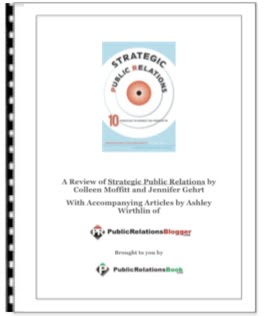________________________________________________________________________
 Because PR can be difficult to control, it is often discredited. According to Dick Lyles, president and chief operating officer of The Ken Blanchard Companies, a full-service consulting and performance improvement company, "People tend to migrate to things they can control. Even now, when an executive looks at an advertising message that's exactly what they want to create, with exactly the right positioning and so forth, they say, 'That's the message I want to send.' That's great, even though people may not read it, or people may give it less value and discount it, because it's advertising.... [On the other hand], if you get a well-placed article in a trade journal or you get some ink, people give it more credibility. The impact is greater, but because it may not come out exactly the way it was intended to come out, [businesspeople frequently] discount it."
Because PR can be difficult to control, it is often discredited. According to Dick Lyles, president and chief operating officer of The Ken Blanchard Companies, a full-service consulting and performance improvement company, "People tend to migrate to things they can control. Even now, when an executive looks at an advertising message that's exactly what they want to create, with exactly the right positioning and so forth, they say, 'That's the message I want to send.' That's great, even though people may not read it, or people may give it less value and discount it, because it's advertising.... [On the other hand], if you get a well-placed article in a trade journal or you get some ink, people give it more credibility. The impact is greater, but because it may not come out exactly the way it was intended to come out, [businesspeople frequently] discount it."
The concepts of Branding and public relations are closely intertwined. The job of public relations is to encourage the public to have positive thoughts about a particular company, product, service, or individual. Branding is the idea that a particular set of attributes will encourage the public to have positive thoughts about a particular company, product, service, or individual. It's a subtle distinction, but an essential one.
In order to best understand Branding and how it is done, it is necessary to examine and explain public relations. Many experts on Branding espouse the opinion that public relations are a vital part-if not the most vital part-of the Branding process. Public relations practitioners are particularly well suited to the Branding concept, since they are well versed in the techniques and practices that create a public identity very close to the central idea of a brand.
Unlike marketing or advertising, which are essential activities and indispensable to the creation of a brand, public relations is not devoted to a tangible object. Advertising executives create television, print, and radio ads; these are concrete, identifiable things. Marketing creates a product-be it a physical product or a service-and presents it to the public. That is an obvious,
noticeable thing; it is not hard to understand.
Public relations does not do either of those things. When properly conceived and executed, a public relations campaign is next to invisible; the public does not know it's there. More to the point, public relations does not create a physical manifestation of its effort: When PR is done right, it doesn't leave the trace of a newspaper or magazine ad, a videotape, or an audiocassette that will win awards-and that can sometimes overwhelm the message being delivered.
What public relations does is to encourage third parties to deliver the message. Why? Because the third parties are news organizations, print journalists, and television and radio news programs and talk shows, which by definition have more credibility for the general public than an advertisement or the word of a company spokesperson.
In other words, public relations is meant to generate news coverage. It does so through planned events and through news stories (true news stories, it should be emphasized) suggested to reporters and their editors. When a newspaper runs an article about the unusual new promotion being done by a local business, that's public relations. But to the reader of that newspaper, it appears to be an article generated by the editorial staff of the publication itself.- There is no advertisement disclaimer that runs over a PR-suggested news article. That makes sense, because the news editor always has the option of ignoring the suggestions made by public relations people. Editors and producers will rely on public relations for news leads, but will not simply act as a conduit presenting the message from the public relations company's client unedited and unconfirmed. Public relations can suggest, but not control, the message being sent. It is a very difficult tightrope to walk.
For example, in 2000, when the Beatles song compilation 1 was being released by Capitol Records, it presented (believe it or not) a public relations dilemma: how to promote an album full of songs that the entire target audience almost certainly owned in another form already.
The problem was solved in a number of ways. First of all, it was emphasized that these were the 27 number one songs the band had produced during its legendary career. Press releases noted over and over again that these songs had never been compiled on one album before. It was intimated that many in the group's core audience might not have heard these songs on CD before, having bought them on vinyl records when they were originally released.
But more than anything, the public relations executives managed to generate publicity for the album with something that no other project could possible offer: access to the (at the time) three surviving Beatles for interview. News programs, interview shows, publications, and talk programs were all given opportunities (albeit brief ones) to interview at least one Beatle, and therefore the album was mentioned on countless air-waves and in publications for weeks before its release, and given very prominent placement.
The album went on to become a smash hit, reaching number one almost 40 years after the initial release of some of the recordings. It was yet another triumph for a legendary recording group, but it was also something of a coup for the public relations personnel involved. Yes, they had the luxury of three of the most famous faces on the planet, and the ability to use them. But the PR people who worked on that project also knew that they had to make something that wasn't necessarily new seem vital and important, and they knew where the news story in the project was kept. Making sure the news got out was their job, and they did it admirably.
The best part: The public was never aware there were PR people involved at all. What average fans saw on TV was Paul McCartney, George Harrison, and/or Ringo Starr. They heard snippets of the songs they had loved for decades. And they were told that this was different; it was new; it was unique. That's all the public needed to know. The fact that this message had been carefully constructed and the interviews painstakingly arranged was irrelevant to consumers; all they needed to know was that the Beatles were, more or less, back.
Public relations works behind the scenes, but its impact on Branding is enormous. Because PR generates interest, and precisely because it is working offstage, it is as valuable a part of the Branding process as can be imagined. And best of all, it's often the, least expensive component in a sophisticated Branding machine.
As Adam Christing, president and founder of Clean Comedians, a company that provides meeting planners with G-rated comedians, says, "Public relations takes the brand and makes it mobile, makes it more visible. It's like taking a band that's been successful in a local neighborhood and taking it out on the road so more people can experience it."
Of course, when the message is not delivered in the form that was initially intended, that means the public relations professional has not done the job properly. The mistake can be in the design of the message itself-in particular, if the message that has been designed is a false or misleading one-or in the method of its delivery. It's a fine thing to have a vital, exciting news story to tell, but if the presentation is ineffective, that story win not be told, or win be
told in such a way that its original intention is lost.
Public relations is about messages and their delivery, but that isn't all PR is. In correlation with Branding, the goal of public relations must always be to create a feeling in the mind of the target audience for which the message is being tailored. If Branding is about creating an identity for a product, service, or entity (company or individual), public relations' contribution to Branding is about making that identity friendly and likable for the public--specifically, the public for which the message is intended.
Obviously, the feeling most PR aspires to create is a positive one. But the intention is vastly more complex than that: In truth, public relations seeks to create and maintain a consistent feeling of familiarity, trust, reliability, and confidence with the targeted public. If advertising is about getting the public's attention, public relations is about delivering the message once the attention has been commanded. When people express an opinion about a product or a company, initially they'll say they like or don't like it, without offering further explanation. But when they're given specific questions about their opinions, the effects of public relations become clear. When products are assigned personality traits or attributes by the public-"friendly," "environmentally aware ... .. concerned with quality ... .. accessible"-it means that public relations, in conjunction with advertising and marketing, has done its job. But because the public is naturally wary of advertising and marketing, and because those disciplines are considerably more visible than public relations, it is possible that PR makes the most honest, and deepest, impact on the public's psyche.
How is the feeling created? Unlike advertising or marketing, public relations alms to influence public opinion without being noticed. So efforts made by companies to create goodwill through advertising and marketing are effective, but will be met with a higher amount of resistance from the public than a public relations campaign.
Michael Levine is the founder of the prominent public relations firm Levine Communications Office, based in Los Angeles. He is the author of Guerrilla PR, 7 Life Lessons from Noah’s Ark: How to Survive a Flood in Your Own Life.
GuerrillaPR . net is a resource for people that want to get famous in the media, without going broke. Visit his website.
Article Source.
Tags: role of public relations in branding, role of media relations in branding, branding and PR, public relations
The Role of Public Relation and Media Relation Programs in Branding
________________________________________
 Because PR can be difficult to control, it is often discredited. According to Dick Lyles, president and chief operating officer of The Ken Blanchard Companies, a full-service consulting and performance improvement company, "People tend to migrate to things they can control. Even now, when an executive looks at an advertising message that's exactly what they want to create, with exactly the right positioning and so forth, they say, 'That's the message I want to send.' That's great, even though people may not read it, or people may give it less value and discount it, because it's advertising.... [On the other hand], if you get a well-placed article in a trade journal or you get some ink, people give it more credibility. The impact is greater, but because it may not come out exactly the way it was intended to come out, [businesspeople frequently] discount it."
Because PR can be difficult to control, it is often discredited. According to Dick Lyles, president and chief operating officer of The Ken Blanchard Companies, a full-service consulting and performance improvement company, "People tend to migrate to things they can control. Even now, when an executive looks at an advertising message that's exactly what they want to create, with exactly the right positioning and so forth, they say, 'That's the message I want to send.' That's great, even though people may not read it, or people may give it less value and discount it, because it's advertising.... [On the other hand], if you get a well-placed article in a trade journal or you get some ink, people give it more credibility. The impact is greater, but because it may not come out exactly the way it was intended to come out, [businesspeople frequently] discount it."The concepts of Branding and public relations are closely intertwined. The job of public relations is to encourage the public to have positive thoughts about a particular company, product, service, or individual. Branding is the idea that a particular set of attributes will encourage the public to have positive thoughts about a particular company, product, service, or individual. It's a subtle distinction, but an essential one.
In order to best understand Branding and how it is done, it is necessary to examine and explain public relations. Many experts on Branding espouse the opinion that public relations are a vital part-if not the most vital part-of the Branding process. Public relations practitioners are particularly well suited to the Branding concept, since they are well versed in the techniques and practices that create a public identity very close to the central idea of a brand.
Unlike marketing or advertising, which are essential activities and indispensable to the creation of a brand, public relations is not devoted to a tangible object. Advertising executives create television, print, and radio ads; these are concrete, identifiable things. Marketing creates a product-be it a physical product or a service-and presents it to the public. That is an obvious,
noticeable thing; it is not hard to understand.
Public relations does not do either of those things. When properly conceived and executed, a public relations campaign is next to invisible; the public does not know it's there. More to the point, public relations does not create a physical manifestation of its effort: When PR is done right, it doesn't leave the trace of a newspaper or magazine ad, a videotape, or an audiocassette that will win awards-and that can sometimes overwhelm the message being delivered.
What public relations does is to encourage third parties to deliver the message. Why? Because the third parties are news organizations, print journalists, and television and radio news programs and talk shows, which by definition have more credibility for the general public than an advertisement or the word of a company spokesperson.
In other words, public relations is meant to generate news coverage. It does so through planned events and through news stories (true news stories, it should be emphasized) suggested to reporters and their editors. When a newspaper runs an article about the unusual new promotion being done by a local business, that's public relations. But to the reader of that newspaper, it appears to be an article generated by the editorial staff of the publication itself.- There is no advertisement disclaimer that runs over a PR-suggested news article. That makes sense, because the news editor always has the option of ignoring the suggestions made by public relations people. Editors and producers will rely on public relations for news leads, but will not simply act as a conduit presenting the message from the public relations company's client unedited and unconfirmed. Public relations can suggest, but not control, the message being sent. It is a very difficult tightrope to walk.
For example, in 2000, when the Beatles song compilation 1 was being released by Capitol Records, it presented (believe it or not) a public relations dilemma: how to promote an album full of songs that the entire target audience almost certainly owned in another form already.
The problem was solved in a number of ways. First of all, it was emphasized that these were the 27 number one songs the band had produced during its legendary career. Press releases noted over and over again that these songs had never been compiled on one album before. It was intimated that many in the group's core audience might not have heard these songs on CD before, having bought them on vinyl records when they were originally released.
But more than anything, the public relations executives managed to generate publicity for the album with something that no other project could possible offer: access to the (at the time) three surviving Beatles for interview. News programs, interview shows, publications, and talk programs were all given opportunities (albeit brief ones) to interview at least one Beatle, and therefore the album was mentioned on countless air-waves and in publications for weeks before its release, and given very prominent placement.
The album went on to become a smash hit, reaching number one almost 40 years after the initial release of some of the recordings. It was yet another triumph for a legendary recording group, but it was also something of a coup for the public relations personnel involved. Yes, they had the luxury of three of the most famous faces on the planet, and the ability to use them. But the PR people who worked on that project also knew that they had to make something that wasn't necessarily new seem vital and important, and they knew where the news story in the project was kept. Making sure the news got out was their job, and they did it admirably.
The best part: The public was never aware there were PR people involved at all. What average fans saw on TV was Paul McCartney, George Harrison, and/or Ringo Starr. They heard snippets of the songs they had loved for decades. And they were told that this was different; it was new; it was unique. That's all the public needed to know. The fact that this message had been carefully constructed and the interviews painstakingly arranged was irrelevant to consumers; all they needed to know was that the Beatles were, more or less, back.
Public relations works behind the scenes, but its impact on Branding is enormous. Because PR generates interest, and precisely because it is working offstage, it is as valuable a part of the Branding process as can be imagined. And best of all, it's often the, least expensive component in a sophisticated Branding machine.
As Adam Christing, president and founder of Clean Comedians, a company that provides meeting planners with G-rated comedians, says, "Public relations takes the brand and makes it mobile, makes it more visible. It's like taking a band that's been successful in a local neighborhood and taking it out on the road so more people can experience it."
Of course, when the message is not delivered in the form that was initially intended, that means the public relations professional has not done the job properly. The mistake can be in the design of the message itself-in particular, if the message that has been designed is a false or misleading one-or in the method of its delivery. It's a fine thing to have a vital, exciting news story to tell, but if the presentation is ineffective, that story win not be told, or win be
told in such a way that its original intention is lost.
Public relations is about messages and their delivery, but that isn't all PR is. In correlation with Branding, the goal of public relations must always be to create a feeling in the mind of the target audience for which the message is being tailored. If Branding is about creating an identity for a product, service, or entity (company or individual), public relations' contribution to Branding is about making that identity friendly and likable for the public--specifically, the public for which the message is intended.
Obviously, the feeling most PR aspires to create is a positive one. But the intention is vastly more complex than that: In truth, public relations seeks to create and maintain a consistent feeling of familiarity, trust, reliability, and confidence with the targeted public. If advertising is about getting the public's attention, public relations is about delivering the message once the attention has been commanded. When people express an opinion about a product or a company, initially they'll say they like or don't like it, without offering further explanation. But when they're given specific questions about their opinions, the effects of public relations become clear. When products are assigned personality traits or attributes by the public-"friendly," "environmentally aware ... .. concerned with quality ... .. accessible"-it means that public relations, in conjunction with advertising and marketing, has done its job. But because the public is naturally wary of advertising and marketing, and because those disciplines are considerably more visible than public relations, it is possible that PR makes the most honest, and deepest, impact on the public's psyche.
How is the feeling created? Unlike advertising or marketing, public relations alms to influence public opinion without being noticed. So efforts made by companies to create goodwill through advertising and marketing are effective, but will be met with a higher amount of resistance from the public than a public relations campaign.
Michael Levine is the founder of the prominent public relations firm Levine Communications Office, based in Los Angeles. He is the author of Guerrilla PR, 7 Life Lessons from Noah’s Ark: How to Survive a Flood in Your Own Life.
GuerrillaPR . net is a resource for people that want to get famous in the media, without going broke. Visit his website.
Article Source.
Tags: role of public relations in branding, role of media relations in branding, branding and PR, public relations
Popular choices
- Non Gamstop Casino
- Mejores Salas De Póker
- Non Gamstop Casinos
- Siti Casino Online Non Aams
- Migliori Siti Casino Online
- UK Online Casinos Not On Gamstop
- Non Gamstop Casino Sites UK
- Non Gamstop Casino Sites UK
- UK Casino Not On Gamstop
- Casinos Not On Gamstop
- Online Casino
- オンラインカジノ
- UK Casino Not On Gamstop
- UK Casino Not On Gamstop
- Reputable Non Gamstop Casinos
- Casinos Not On Gamstop
- Best Non Gamstop Casinos
- Non Gamstop Casino
- Casinos Not On Gamstop
- Slots Not On Gamstop
- Non Gamstop Casino
- Casino Non Aams
- Casinos Not On Gamstop
- Betting Sites Not On Gamstop
- Casino Online Italia
Subscribe to:
Post Comments (Atom)






Comments (0)
Post a Comment